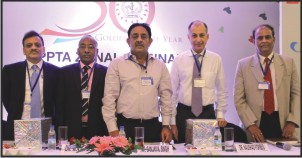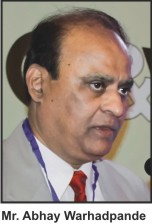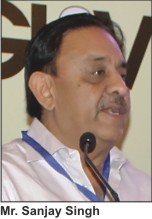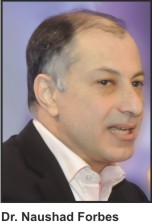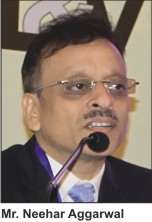As part of its ongoing golden jubilee celebrations, Indian Pulp and Paper Technical Association (IPPTA) organised a zonal seminar on “Best Maintenance Practices in Pulp and Paper Mill to Improve Profitability” at Le Meridien, Pune, on 17th and 18th July, 2014. The seminar was followed by a panel discussion and five information-packed technical sessions that covered topics ranging from “condition-based diagnostics techniques for maintenance” “to “best maintenance practices” and the “role of training and safety in maintenance.”
Welcoming the audience at the inaugural session of the seminar, Mr. Abhay Warhadpande, Chairman-Programme Committee, Managing Director, GL&V India Private Limited, Pune, said, “This is for the first time that Pune has organised an IPPTA event. We have taken a lot of interest in organising this event, as IPPTA is celebrating its golden jubilee. Getting an opportunity to host this event is a matter of honour for the people of Pune. And I hope all of us here will love to join us in celebrating this great occasion with a lot of enthusiasm and joy. These two days will be full of information-sharing and interactive sessions. And I hope that something good will emerge from the discussions and debates that will take place during these two days.”
.
.
.
Reducing Cost
Giving the presidential address at the seminar, Mr. Sanjay Singh, President-IPPTA, Divisional Chief Executive, ITC Limited-PSPD, said, “We are celebrating the Golden Jubilee of IPPTA. Celebrations started in March, and we decided to continue them throughout the year. After the Delhi seminar, we had another one in Kolkata. Then we decided to have one in Pune. The next one will be held in Chennai. The ongoing celebrations will come to an end in Hyderabad. So, we’ll be covering practically the whole of the country.
“The paper industry is one of the most difficult industries in the country. But it is also the most sustainable industry in the world. It is commonly believed that paper mills cut a lot of trees and use a lot of water and energy. Well, let me tell you that those are all things of the past. We are the most sustainable industry among all the industries. Look at steel and aluminum industries. They depend on natural resources, and these resources are not going to last forever. In the coming 100 to 200 years, there’ll be no iron ore left; no aluminum; no stones. But paper industry will stay for thousands of years…
“Many feel that we cut trees, but what they don’t know is that we plant more trees than we cut. For every tree that we cut, we plant two trees. So, we are, in effect, increasing the country’s green cover. Unfortunately, we have not marketed this industry well. This is why I make it a point to speak about the sustainability of paper industry at every forum I visit. I make it a point to tell the audience that paper industry is a very sustainable and green industry. We used to use a lot of energy once upon a time, but over the years, we’ve brought down our energy consumption level by 30 to 40 per cent. Of all the energy that paper mills currently use, nearly 40 to 50 per cent is generated from black liquor. How many industries are generating energy in this fashion? Also, we used to use a lot of water. It was around 200 cubic metres per ton of paper produced. Innovation has played a key role in bringing down our water consumption level to 30 to 40 cubic metres per ton of paper. After we use water, we treat it well and give it to local farmers in the nearby community to irrigate their land. To this treated water we also add a lot of urea and some other phosphates. These substances enrich the soil. We are certainly a very sustainable industry.
“But paper industry has a few challenges to face. First and foremost, this industry is very cyclic in nature. Cost of raw materials and energy keeps increasing year after year. As you know, India is an energy-starved country. There is a shortage of energy in the country, and the demand for energy is increasing. The government controls coal and oil prices, which it keeps increasing. In the last few years, the average cost has increased about 5 to 6 per cent. Also, inflation is rather high in the country – 7 to 8 per cent. A lot of effort is being made by the government to bring down inflation, but inflation is very much here. So salaries and wages keep increasing by 10 to 12 per cent every year. The cost of energy keeps increasing by 6 to 7 per cent. Raw material prices – wood, waste paper and agro-based raw material – are also increasing year after year. And all this is beyond our control. We can control only internal efficiencies. We can control our energy consumption; reduce our maintenance downtime and so on. And this is why we’ll be talking about cost reduction at this seminar.
“I recently met a small paper mill owner. I asked him how small paper mills were managing to survive in an environment where even big paper mills were struggling to survive. Let me tell you that when you produce 1 ton of paper/ board, you normally consume 2 to 2.2 tons of steam. This mill owner said he was using only 1.3 tons of steam to produce 1 ton of paper/board. I thought this figure may well be treated as a benchmark or something. When I asked him how he managed to do it, he said something that really surprised me. He said that he had a press that he pressed very hard. According to the specifications given by the company that made the press he had, he was supposed to make the press do, let’s say, 200 newton metres of work. But he went for 210 to 280 newton metres of work – till the press broke. By doing that he got an idea of the safety margin in the press. Now he goes for 260 or 270 – not stepping beyond the margin of safety. And that was how he managed to bring down the level of his steam consumption. Isn’t this innovation? It surely is… . The quality of his products may not be as expected, but his products are selling. So, in paper industry, we need to be innovative to survive. Survival means becoming tougher. We can survive by reducing our cost – that seems to be the only way. And the purpose of this seminar is to help paper mills reduce their cost of maintenance.”
Illuminating Insights
Delivering the keynote address at the seminar, Dr. Naushad Forbes, President, CII, Director, Forbes Marshall Private Limited, said, “I will make two points: First, customer needs have led us to define new business, in particular new service businesses; and second, the road from reactive maintenance to preventive maintenance to predictive maintenance is difficult and long and as much about mindset and culture as about anything technical.
About twenty years ago, we started doing audits of steam systems, a service we now conduct worldwide. Together with CII we have done work to benchmark plants in the same industry on energy consumption. We have found some interesting data. First, the gap between the average plant and the best plant is around 21 per cent. It was 21 percent 10 years ago, and after a lot of improvement it is still 21 per cent today. Second, the gap arises from a mix of factors – installing the right energy conservation equipment is necessary, but it is not sufficient. Third, however, the gap is not only a matter of the right equipment. I like to say that buying a highly efficient steam boiler does not necessarily mean one has highly efficient steam generation. How one operates the boiler is just as important. Our new forbesvyncke boilers routinely operate at 80 per cent on biomass, but that is because they are completely automated, and they will simply not operate if doors are not sealed, combustion measurement is defective, or the ash removal system jams.
“As these gaps have become clear to us, we have responded with the new service offerings. For example, our steam system management service is an ongoing engagement to sustain energy efficiency and build competence and good engineering practices in the plant.
A focus on maintenance may not sound very exciting, but the potential is great, and I complement IPPTA on picking so valuable a topic for their seminar this year.”
Industry-Academia Interaction
The inaugural speech was given by Chief Guest Dr. W.N. Gade, Vice Chancellor, University of Pune. Speaking at the inaugural session, he said, “If you look back, you’ll notice that a lot of development and innovation have taken place in pulp and paper manufacturing. Today’s paper industry stands as a modernised industry. But still there is a lot of scope for improvement. Nevertheless, I congratulate IPPTA on the completion of 50 years. I am very happy to know that this is IPPTA’s golden jubilee year. On behalf of the city of Pune and University of Pune, I extend a very warm welcome to all the delegates coming from different parts of the country… .
“Academic institutions and paper industry can help each other in so many ways. It is always better to work in symbiotic association. Mr. Sanjay Singh talked about bringing down the cost of paper production. I think that’s an important issue. I’ll explain why it is important. University of Pune has 70,000 students and runs a large number of courses. We use one crore answer sheets every year. That comes to more than 100 metric tons of paper. The cost of this paper is unbelievable; we spend crores of rupees on it every year. If this cost can be brought down, the public at large will be benefitted. And if you really want to bring down the cost of paper, academic institutions can really help you in achieving this target. We can identify certain areas where academic institutions can play a key role. Academic institutes are good at doing quality research work. So, certain things can be done at research institutes and certain things can be done in the industry… . Industry-academia collaboration should be encouraged. We need to identify the areas where industry and academia can work together for mutual benefit. University of Pune has a very good energy department. It also has an excellent environment department; it has a good science department as well. We are also involved in doing a large number of projects for industries.
“India has a large pool of technical manpower… When we have a lot of technical manpower, why is it that we cannot become a leader in areas that concern us? We must try to become leaders in areas that matter to us the most. We have not been able to fully use the huge technical manpower we have to our advantage. So, there is a need for doing things differently. We need to take a critical look at our methods, our technologies, our culture, our attitude. We need to remember that India is a huge country and that market requirement is going to be enormous in times to come. A large number of foreign industries look at India as a market. We should, therefore, avail ourselves of the opportunities that India presents.
“Research and development can play an important role in bringing down the cost of paper. It can boost innovation… . The academic institutions in the country are quite well established. But there is the problem of employment among the graduates and post-graduates we produce. This is because our curriculums lack the skill-acquisition element. Academic institutions have probably not been able to understand Indian industries’ requirements. So, with the help of industries, we can introduce skill-development courses, and that will surely help in enhancing the employment potential of our graduates and post-graduates. In addition, industries will get a ready manpower; they will not have to train them as per their requirements. So, industry-academia interaction is of paramount importance…. Industries must have trust in academic institutions, and academic institutions must have confidence in industries.”
Vote of Thanks
Mr. Neehar Aggarwal, Vice President-IPPTA, COO, Ballarpur Int. Graphic Paper Holding B.V. , Gurgaon, gave the vote of thanks. He thanked the speakers for gracing the occasion with their presence and for sharing their thoughts and ideas with the audience.
The inaugural session was followed by a panel discussion and five technical sessions.


